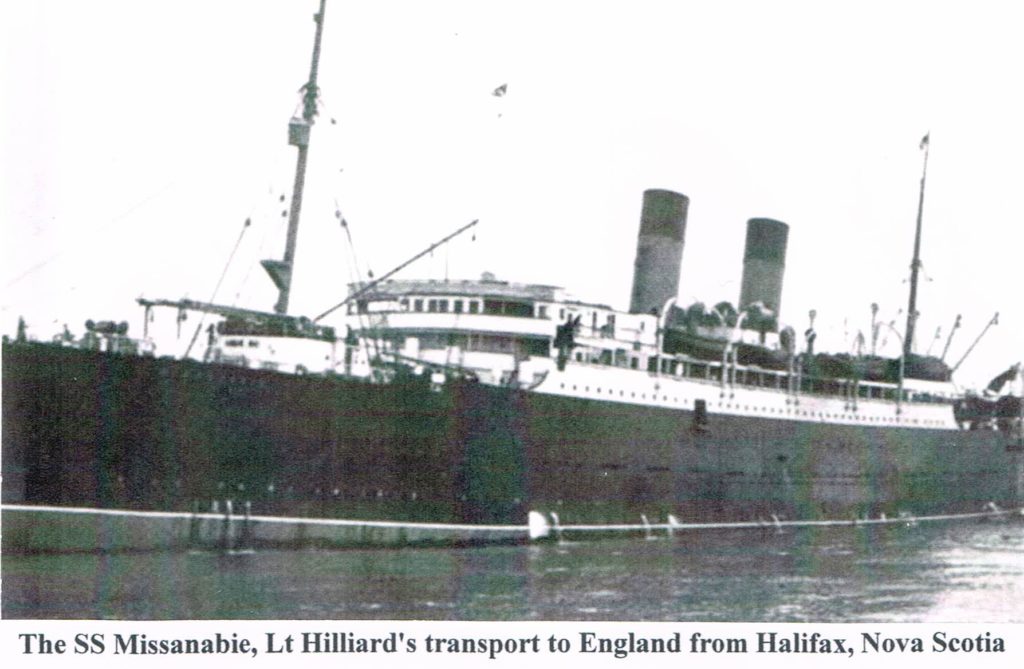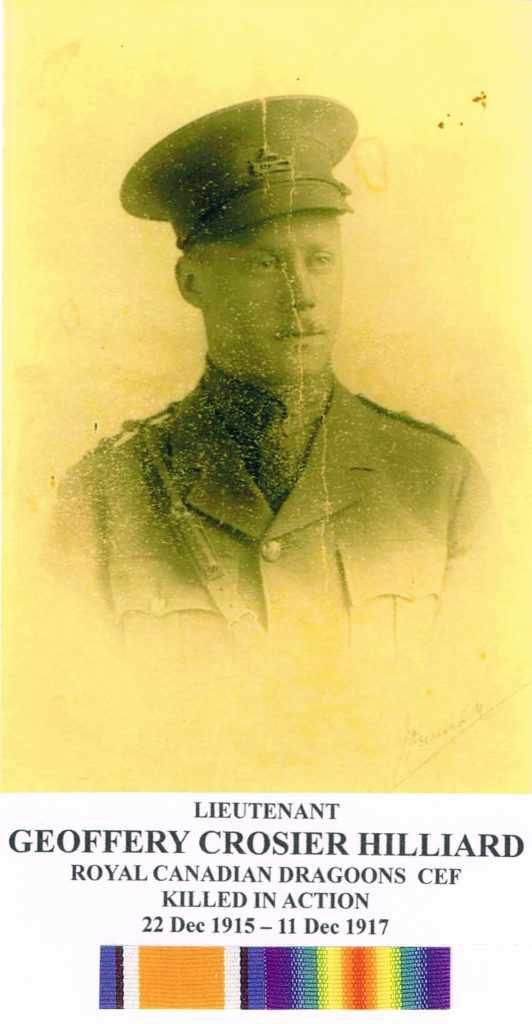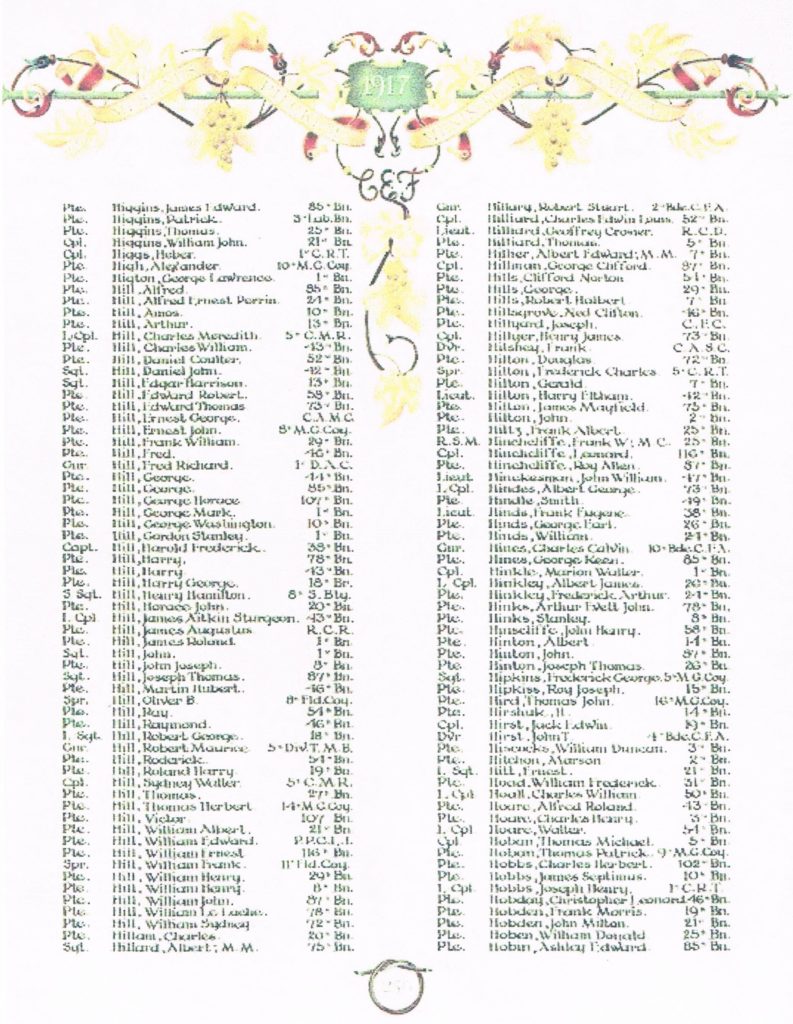MILITARY HISTORY
Lieutenant Geoffery Crosier Hilliard – ACTIVE SERVICE (World War I)
On December 22nd, 1915 Geoffery Crosier Hilliard completed the Officer Declaration Paper for enlistment with the Canadian Army, Canadian Expeditionary Force (CEF). At the time of signing the Declaration he was 18 years, 9 months and 7 days old. He gives Stanley Barracks, Toronto Ontario as his address. Geoffery Crosier lists the Royal Canadian Dragoons (RCD) [Permanent Force] as his Unit. Geoffery Crosier gave his birth-date as March 17, 1897 and that he was born in Lakefield, Ontario. His next-of-kin is given as his father, George Boyce Hilliard of Lakefield. As far as particulars of former Military Service, he indicated 1 year and 2 months at the Royal Military College, Kingston Ontario. Research indicates that Geoffery Crosier attended Highfield School, which is part of Hillfield Strathalan College, a Private School in Hamilton, Ontario in 1913 and 1914. He attended the Royal Military College in 1914 and 1915.
There is no indication in Lieut Hilliard’s records for his employment for the period from December 1915 to December 1916. Possibly he was employed at Stanley Barracks which was used as an enemy internment camp until October 1916.On January 16th, 1917 while he was stationed at Stanley Barracks Toronto, Lieut Geoffrey Crosier Hilliard made out his Will bequeathing all his possessions to his father. On February 23, 1917 his Medical Examination was completed in Toronto and he was deemed fit for Service with the Canadian Expeditionary Force, Oversea. He indicated that he was single.
Lieut Hilliard embarked for England March 26, 1917 aboard the SS Missanabie as part of the 7th Draft of the RCD. There is no indication as to the Port of departure. On April 5th, 1917 while on-board the SS Missanabie, he underwent another Medical Examination. His age is shown as 20 years old. He was 5′ 9 ¾” tall, weighed 165 pounds and had a 37 ½” chest (expanded). He disembarked in England on April 7, 1917.

On April 7, 1917 Lieut Hilliard was taken-on-strength with the Canadian Reserve Cavalry Regiment (CRCR) at Shorncliffe, England. On August 16, 1917 Lieut Hilliard was struck-off-strength from the CRCR having proceeded Overseas with the 72nd Canadian Infantry Battalion (Cdn Inf Bn). Another entry in his Military File crosses out the 72nd and is replaced with the 19th Battalion. On August 17, 1917 Lieut Hilliard is at the Canadian Base Depot at Le Havre, France. On the same day Lieut Hilliard is ”attached for duty” with the 19th Cdn Inf Bn (on exchange from CRCR). Although he was struck-off-strength from the CRCR on August 16, 1917; he was still mentioned as being on exchange from the CRCR. August 27, 1917 he joined the 19th in the Field.
Lieut Hilliard’s Military File indicates that the 19th Cdn Inf Bn remained with the RCD (1st Armoured Regiment), but that he was ”attached” to the 19th Cdn Inf Bn.
The 19th Canadian Infantry Battalion was attached to the 4th Canadian Infantry Brigade – 2nd Canadian Division.
There are no entries in his Military File from August 27th, 1917 and November 11th, 1917. To track the movements of Lieut Hilliard, the War Diary of the 19th Canadian Infantry Battalion was used.
August 1917 when Lieut Hilliard joined the 19th Battalion in the Field, the entire 4th Canadian Infantry Brigade had been withdrawn to its Training Ground at Villers au Bois. On the 27th the 4th Infantry Brigade was inspected by its Commander in Chief. The 19th Battalion was engaged in Platoon and Company Drills from the 28th to 30th. On the 31st the Battalion was inspected by the General Officer Commanding (GOC)
September 1917 the 1st to 7th were spent training in Platoons and Companies. On the evening of the 7th a Tattoo was arranged by the General Officer Commanding (GOC) of the 4th Brigade was given by massed bands from all of the Canadian Divisions. The GOC of the Canadian Corps and 2nd Canadian Division were present with their Staffs. The 8th to 13th were spent in Company and Specialist Training, a 2nd Cdn Divisional Rifle Shoot, and a 4th Cdn Inf Bde Sports Day. On the 14th the 19th Battalion was ordered to go into Brigade Support. At 1:30 PM, it left Villers au Bois and proceeded to their Support position arriving at 9:30 PM. ”A” Company in Paynesley Tunnel, ”B” Company in Vimy Village, with ”C & D” Companies and Headquarters in Bois de la Folie. Battalion strength is listed as 27 Officers and 626 other ranks. On the 15th ”C & D” Companies received orders to move forward to make way for the 20th Cdn Battalion. Headquarters moved to a gun pit in the Lens – Arras Railroad bank, 600 yards north of Vimy Station. ”C” Company remained in the area of Bois de la Folie, ”D” Company moved to dugouts in the Brick Fields in Chaudiere. Move was complete by 10:00 PM. ”B” Company carried wire to the Front-Line during the night of 15th/16th. On the 16th 200 other ranks from”B”,”C” and “D” Companies were ordered on fatigue on the night of 16th/17th. They were employed digging a new Front-Line trench. There was no enemy activity. The 17th ”A” Company moved to dugouts and shelters in the vicinity of Nanaimo Road during the night of 17th/18th. Men from ”B”,”C”, and “D” Companies spent the night deepening and extending Billie Burke trench. The 18th and 19th were spent continuing work in Billie Burke trench. On the 20th the Battalion was relieved by the 22nd Cdn Inf Bn. Relief was complete by 10:30 PM. The Battalion moved to huts in Chamblain L’Abbe. The 21st to 23rd were spent resting, bath parades, inspections, and reorganization. On the 24th ”A” & “B” Companies underwent Specialist training, while ”C” & “D” Companies proceeded to ”taped area” for attack training. On the 25th the training was reversed. On the 26th the Battalion relieved the 29th Cdn Inf Bn in Divisional Support at Neuville St. Vaast. The Battalion moved off in intervals at 5:15 PM and relief was complete at 8:55 PM. All ranks were billeted in cellars and dugouts. Battalion strength is now shown as 32 Officers and 746 other ranks. The 27th to 30th were spent on night fatigues deepening Front-Line trenches and laying buried signal cables.
October 1917 the month opens with the 19th Battalion was still in cellars and dugouts at Neuville St. Vaast. On the 2nd they were ordered to relieve the 27th Cdn Inf Bn in the Front-Line. During the night of the 2nd/3rd ”B & D” Companies sent out covering Patrols into No-Man’s-Land, and a Battalion Patrol was sent out from 12:30 AM to 3:00 AM. No enemy Patrols were encountered. On the 3rd there was some enemy shelling on the Front-Line trench with two casualties. Men were engaged on fatigues the night of the 3rd/4th, improving Front-Line trenches and dugouts. Patrols were sent out, but no enemy were encountered. The 4th was a repeat of the 3rd. During the night of the 5th/6th inter-Company relief was effected. ”A” Company relieved ”B” Company in the right Front-Line and ”C” Company relieved ”D” Company on the left Front-
Line. There were the usual night Patrols and work parties. The 6th and 7th were a repeat of the 5th. On the 8th Battalion Headquarters, along with ”A” & “C” Companies on relief by the 18th Cdn Inf Bn moved to trenches on Vimy Ridge. ”B” & “D” Companies remained in Canada Trench. During the day of the 9th the Battalion Headquarters, ”A” & “C” Companies moved back to billets at Neuville St. Vaast, and during the night of the
9th/10th ”B” & “D” Companies were relieved and rejoined the rest of the Battalion. On the 10th at 4:00 PM the Battalion was relieved by the 29th Cdn Inf Bn and moved to billets at Villers au Bois. The 11th to 14th was spent in Company and Specialist training. On the 15th, in accordance with orders, the Battalion moved from Villers au Bois to Dieval, northern France, on route to a new Front. It left at 9:00 AM and marched through several villages arriving at Dieval at 4:00 PM. The 16th to 23rd was spent in various types of training. Starting at midnight 23rd/24th the Battalion commenced a move to Belgium. It entrained at Ligny St. Fochel at 3:30 AM and arrived at Caestre at 2:00 PM. At 5:00 AM, on the 25th it arrived at Ypres. The Battalion marched single file through the Menin Gate to Potinze, where it went under canvas in an open field. The 26th to 28th was spent in work and fatigue parties. On the 29th the Battalion was relieved by the 20th Cdn Inf Bn and it moved to huts in the vicinity of Vlamertinge, Belgium. The 30th and 31st were spent in Platoon Drills and kit inspections.
November 1917 the month opened with the 19th Battalion still in huts at Vlamertinge, Belgium. On the night of the 2nd/3rd the Battalion relieved the 28th Cdn Inf Bn in the Line. ”D” Company on the right Front, ”B” Company on the left Front, ”C” Company in support, and ”A” Company in reserve. Battalion strength was listed as: 18 Officers and 549 other ranks. At 4:40 AM, the enemy opened up a very heavy bombardment, which was immediately replied to by Allied guns. Under the cover of the barrage, the enemy endeavoured an attack, but none reached the Battalion Front. On the night of the 4th/5th the Battalion was relieved by the 24th Cdn Inf Bn and moved back to position in the rear in the Potijze area. While in the Front-Line the Battalion suffered 85 casualties. The evening of the 5th, they left Potijze and proceeded to huts at Brandhoek. The 6th and 7th were spent reorganizing and undergoing Company and Platoon drills. On the 8th, the Battalion left Brandhoek for the Front-Line, entraining at 7:25 AM and detraining at Ypres at 8:00 AM. They now started a march to the Front-Line. As a result of the relief being carried out in the daylight and enemy retaliating to Allied fire, casualties resulted. The relief was complete on the right Front-Line by 8:45 PM. Battalion disbursement was: ”A” Company on the left Front, ”C” Company the right Front, ”D” Company was in support, and ”B” Company in reserve. There was sporadic shelling of Battalion Front-Line positions during the day, which picked up during the evening hours and continued until 6:05 AM on the 10th. At this point an Allied attack barrage opened up on enemy positions. Shelling, by both sides, now became extremely heavy. The Battalion on the left of the 19th Bn attacked into No-Man’s-Land. It now began to rain very heavily, filling the trenches and shell holes until the men were standing up to their knees in water. Heavy shelling continued throughout the day. On the 11th the shelling slackened considerably during the day and the weather improved. During this tour in the Front-Line, the Battalion suffered 117 casualties in total. The War Diary specifically mentioned Lieut G. C. Hilliard as being one of the wounded.
An entry in his Military File indicates Lieut Hilliard was wounded on November 11, 1917 and that he had been evacuated to the No 1 British Red Cross Hospital, also known as the Duchess of Westminster’s Hospital at Le Touquet, France. The wounds were listed as Gunshot wounds to left arm, face, head, and shoulder. On November 21, 1917 he was reported as dangerously ill. Due to the gravity of the wounds and the onset of Streptococcal Infection, he was unable to be evacuated to England. On December 11, 1917 Lieutenant Geoffrey Crosier Hilliard was listed as having died of wounds.
Lieutenant Geoffrey Crosier Hilliard is buried in Étaples Military Cemetery, Pas de Calais, France. The Cemetery is located on the north side of the town of Étaples, on the west side of the road to Boulogne.
Lieutenant Geoffrey Crosier Hilliard is commemorated on the Memorial Tablet at Hillfield – Strathallan College, Hamilton, Ontario; and the Memorial Arch at the Royal Military College of Canada, in Kingston, Ontario. His name appears on page 256 of the First World War Book of Remembrance.
There is a note in the File indicating that Lieutenant Hilliard was not eligible to receive the 1914 – 15 Star. Based on his Military Service, he should have received the:
British War Medal 1914 – 1920; and
Victory Medal.
He also qualified for War Service Badge CEF Class “A”.
Lieutenant Hilliard’s medals were sent to his father, who was now living in Victoria, British Columbia on February 19, 1921. The Memorial Scroll and Plaque were sent October 21, 1921. The Memorial Cross was sent to his mother Amy H. Hilliard, also of Victoria, on October 19, 1920.
Based on his Military File, Lieutenant Geoffrey Crosier Hilliard served a total of 1 year, 11 months, and 19 days with the Canadian Expeditionary Force: 1 year – 3 months and 4 days in Canada, 4 months and 22 days in England, and 3 months and 24 days in France.
An excerpt from an article in Maclean’s Magazine by Barbara Ameil, September 1996:
”The Military is the single calling in the world with job specifications that include a commitment to die for your country. What could be more honourable”?
PERSONAL HISTORY
GEOFFREY CROSIER HILLIARD
Geoffrey Crosier Hilliard was born in Lakefield on March 17, 1897, son of George Boyce Hilliard and Amy Herbert Barlee. Geoffrey Crosier was raised in Lakefield and went on to attend the Royal Military College in Kingston; later joining the Royal Canadian Dragoons (Permanent Force) stationed in the Stanley Barracks in Toronto, Ontario.
Lieutenant Geoffrey Crosier Hilliard was killed in action in France and is remembered with honour in Étaples Military Cemetery near Boulogne, France.
The following is taken from the Royal Military College Club (Kingston, Ontario)
1073 Lieut. Geoffrey Crosier Hilliard (RMC 1914) was born March 17, 1897, the son of George B. and Amy H. Hilliard, of Lakefield. He studied at Highfield College, Upper Canada 1913-14 and at the Royal Military College of Canada 1914-15.
He served with the Royal Canadian Dragoons. Geoffrey Hilliard was one of the noblest type of young man. His strong face, strong physique and strong, clean soul endeared him to the best of his comrades at Highfield, at the RMC, and in the Royal Canadian Dragoons, with whom his military life was spent. He died of wounds December 11th, 1917 at 20 years of age. His grave is XXVIII. D. 5. Étaples Military Cemetery in Pas de Calais, France.
He is commemorated on the Memorial Tablet at Hillfield-Strathallan College, the Memorial Arch at the Royal Military College of Canada, and on page 256 of the First World War Book of Remembrance. Also see “Echoes that Remain” by M.B. (Barry) Wansbrough, (2001 Hillfield Strathallan College).
THE GEOFFREY CROSIER HILLIARD FAMILY OF LAKEFIELD
Geoffrey Crosier Hilliard’s paternal grandparents are George Towers Hilliard and Frances Coombe. His maternal grandparents are Frederick Barlee and Emma Susanna Strickland.
Geoffrey Crosier Hilliard’s parents; George Boyce Hilliard, born October 26 1856 in Penang, Straits of Malacca, India and Amy Herbert Barlee, born on September 21, 1863 were married on February 2, 1886 in Lakefield, Ontario. George Boyce was residing in Minnedosa, Manitoba; he and Amy resided there for the first few years of their marriage before moving to Lakefield about 1890. They had a family of three children – George Fredrick Herbert Hilliard, Dorothy Grace Hilliard and Geoffrey Crosier Hilliard.
Amy and George Hilliard continued to live on Strickland Street in Lakefield as Amy’s mother Emma had come to live with them until her death in 1913. George worked as Secretary-Treasurer of the Grove School from 1905 until his retirement in 1920. George Fredrick Herbert Hilliard became a civil engineer and settled in Monarch, Alberta until his retirement. Dorothy Grace had settled in Victoria, British Columbia (BC). After George’s retirement in 1920, Amy and George Hilliard decided to move from Lakefield to Victoria, BC to be near their daughter. Amy passed away on March 15, 1938 in Colwood, BC then George moved in with his daughter Grace Forrester in Victoria, BC and resided with her until his death on May 21, 1943; both are interred in BC.

